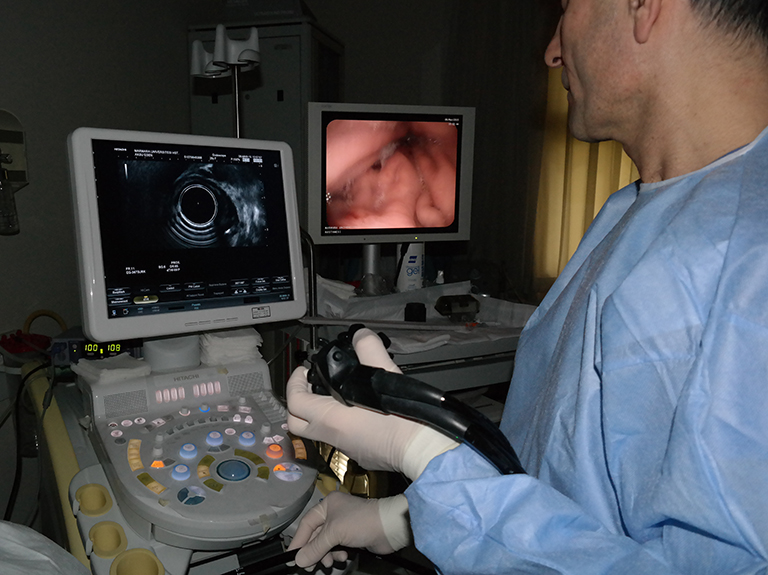Endoscopic Ultrasonography
WHAT IS ENDOSCOPIC ULTRASONOGRAPHY (EUS)?

Endoscopic ultrasonography (EUS) is a method used to examine the esophagus, stomach, duodenum, and the last part of the large intestine (rectum). The endoscope is a finger-thick, thin, flexible instrument. It is inserted through the mouth into the esophagus, stomach and then into the duodenum or through the anus and advanced to the last part of the large intestine. With the light source at the tip, a small video camera (endoscopy device), the inside of the intestines is seen. In the EUS device, there is also an ultrasound apparatus at the end of the endoscope. In this way, the mentioned digestive system organs are evaluated. At the same time, adjacent to these organs; lungs, liver, gallbladder, and pancreas are also evaluated. Again, when necessary, a tissue sample (biopsy) is taken with a long wire, which is passed through a thin channel of the endoscope and has a clamp at the end that is used to grab the tissue and take a piece.
WHY IS EUS DONE?
EUS is performed to obtain additional or complementary data to the information obtained by imaging methods (computed tomography, magnetic resonance imaging, etc.) performed to evaluate abdominal or chest pains, digestive system and chest cavity. For example, it can help us determine treatment options by providing information about the source of a mass detected by other imaging methods. It can help to reveal more clearly the diseases that cannot be determined by other examinations or that are controversial;
- Evaluation of cancers of the lung, colon, rectum, esophagus (esophagus), stomach, duodenum (duodenum), pancreas, ampulla
- lymphoma
- Barrett's esophagus
- Pancreatitis, pancreatic cysts and tumors
- Bile duct and gallbladder stones and tumors
- Rectal fistula and fecal incontinence (gas-stool incontinence)
- In its diagnosis and differential diagnosis such as sarcoidosis
- It is done to guide the evacuation of some fluid accumulations (pancreatic pseudocyst, etc.) in the abdomen.
WHY IS EUS PERFORMED IN CANCER PATIENTS?
EUS gives information about the extent to which some cancers of the digestive system and respiratory system have spread.
- How deep is the cancer in the organ,
- Whether it has spread to neighboring organs and lymph nodes
- Determining the stage of cancer
- By allowing biopsy, it helps us both to establish the diagnosis and to determine which treatment would be appropriate.
WHAT ARE THE RISK EUS?
Although it is a safe procedure in general;
- Bleeding
- Infection
- Perforation of the esophagus, intestine or throat
- Pancreatitis (inflammation of the pancreas), especially if a biopsy has been done
WHAT PREPARATIONS SHOULD PATIENTS MAKE FOR EUS?
In the procedures to be performed for the upper part of the digestive system (esophagus, stomach, duodenum), nothing should be eaten or drunk at least 6 hours before the procedure.
In the procedures to be performed for the rectum, it is necessary to clean the intestines and take clear food.
If anticoagulants are used because they will increase the risk of bleeding, they should be discontinued a certain time before the procedure.
The doctor should be informed about all drugs used and previous diseases.
